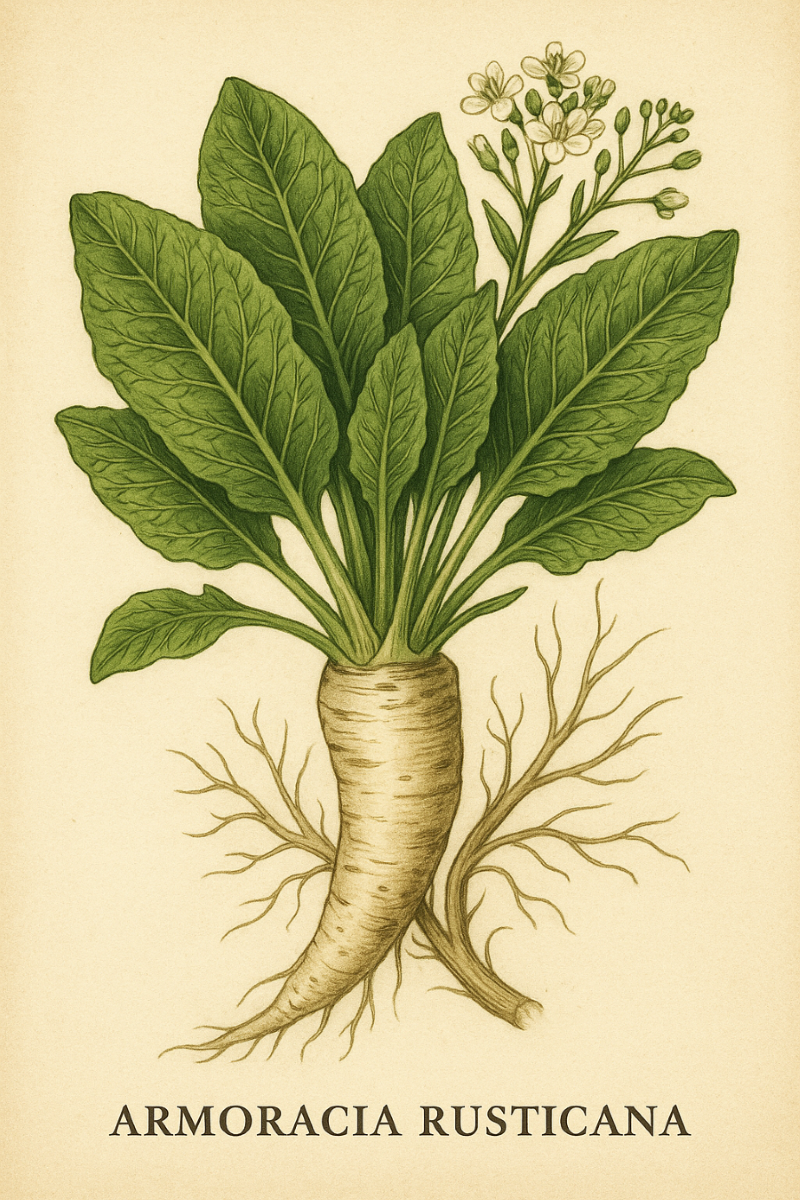Horseradish or Rafano: The Spicy Root in the Layers of Tradition
There’s a root that carries fire, history, and surprise in its fibers. In Sweden it’s pepparrot, in Italy rafano. Its botanical name is Armoracia rusticana — a perennial from the mustard family (Brassicaceae) — and its pungent bite has inspired condiments, cures, and culinary experiments for millennia.
In this post, we trace its story: its origins, old medicinal and culinary uses, how it thrives in the soils of Northern Europe and Northern Italy, and how we at Lasagnariet dared to bring its sharpness into lasagna.
From Ancient Roots to Modern Tables
Horseradish is thought to have originated in Southeastern Europe and Western Asia, but today it grows naturally across temperate Europe and far beyond. As a perennial, it survives the winter hidden underground and sends up new growth every spring. It thrives best in deep, friable, well-drained soils rich in organic matter. The sandy soils of certain regions are perfect, because they allow the roots to stretch straight and long without obstruction. If the ground is too stony or compact, the roots fork and twist, losing their prized shape. Cultivators often prefer to plant root segments rather than seeds, ensuring strong growth and predictable pungency. Harvest usually takes place in late autumn, around October and November, after the first frost has deepened the flavor. In some traditions, roots are also dug in early spring before new shoots appear.
It is worth noting that horseradish has a famous cousin: wasabi. True wasabi (Eutrema japonicum) is notoriously difficult to grow and very expensive, so most “wasabi pastes” are actually made from horseradish blended with green coloring.
Historical & Medicinal Tradition
From the moment you dig a root and catch its sharp aroma, you touch centuries of human tradition. In ancient Egypt, horseradish was already mentioned as a medicinal plant as early as 1500 BC. The Greeks and Romans used it both in the kitchen and in medicine, as a rub for back pain, a tonic for respiratory issues, and a general stimulant. During the Middle Ages, across Scandinavia and Europe, both root and leaves were valued against coughs, rheumatism, digestive problems, and urinary complaints. Renaissance herbalists like Leonhart Fuchs described horseradish as both cure and condiment. Folk medicine even credited it with helping against scurvy, worms, swollen livers, and colds. In Jewish tradition, freshly grated horseradish still holds its place as marror, the bitter herb of the Passover Seder.
This root has always stood at the intersection of flavor and healing.
Rafano in Northern Italy vs Pepparrot in Sweden
In Italy, horseradish is known as rafano or cren, especially in the north. In Friuli, Veneto, Trentino and Alto Adige, it is grated into sauces or served with bollito — boiled meats and sausages. In Basilicata, rafanata is a rustic frittata with horseradish, potatoes, pecorino, and eggs, a dish tied to carnival traditions. There is also ferricelli al rafano, a fiery pasta dressed with freshly grated horseradish. Some say the Normans introduced the root to southern Italy in the Middle Ages, where it became part of regional cooking.
In Sweden, pepparrot has long been paired with fish, gravlax, smoked salmon, boiled potatoes, and sill. Hardy and resilient, it thrived in household gardens for centuries and became an everyday condiment. Unlike Italy, where rafano often appears grated at the table, Sweden wove it into daily meals as a sharp, invigorating accent. Two cultures, two uses, but the same respect for its fire.
From Root to Lasagna: Our Experiment
At Lasagnariet, we love to connect the unexpected. So we asked ourselves: what if horseradish could become part of a lasagna? Not as a gimmick, but as an honest experiment — a way of letting tradition and surprise meet layer by layer.
We started with pasta sheets infused with parsley, their soft green color and fresh herbal aroma creating a natural contrast to the root’s heat. The béchamel was rich, made with equal parts milk and cream, thick enough to carry the spice but still silky. Into this we folded freshly grated horseradish, careful to strike a balance between pungency and smoothness. For the ragù, we chose a white beef version without tomatoes, keeping the flavors gentle so the horseradish could shine. Between the layers we slipped roasted celeriac slices, adding earthy depth and structure that echoed the root itself. On top, a golden Parmigiano crust sealed the dish.
And then, the detail that brings it all together: just before serving, we scattered another touch of freshly grated horseradish over the steaming slice. That final lift — sharp, fragrant, almost electric — cuts through the creaminess and wakes the dish alive.
This is how we imagined horseradish in lasagna: not screaming for attention, but singing quietly in harmony with each layer.
Health, Flavor, and Respect
Horseradish is not only exciting for the palate. It carries vitamin C, potassium, magnesium, and other minerals. Its sharp compounds — glucosinolates and allyl isothiocyanate — are studied for antibacterial, anti-inflammatory, and even anticancer properties. It has been used to stimulate digestion, clear congestion, and support circulation. Folk traditions believed it could ease rheumatism, coughs, and infections. Of course, too much can irritate, which is why moderation has always been part of its wisdom.
Roots anchor us, and this one — pepparrot in Sweden, rafano in Italy — has anchored itself in countless kitchens and stories. At Lasagnariet, we believe innovation is not about breaking tradition, but about dancing with it.
So yes, we layered horseradish into lasagna. Not to shock, but to whisper. Not to dominate, but to enter into dialogue. Because every layer, every bite, carries history, geography, and a choice: to surprise, or to comfort.
If you try this recipe — or adapt it with mushrooms, spinach, or another root — we’d love to hear how your layers turn out.
Lasagnariet, where even spiciness finds its layer.

